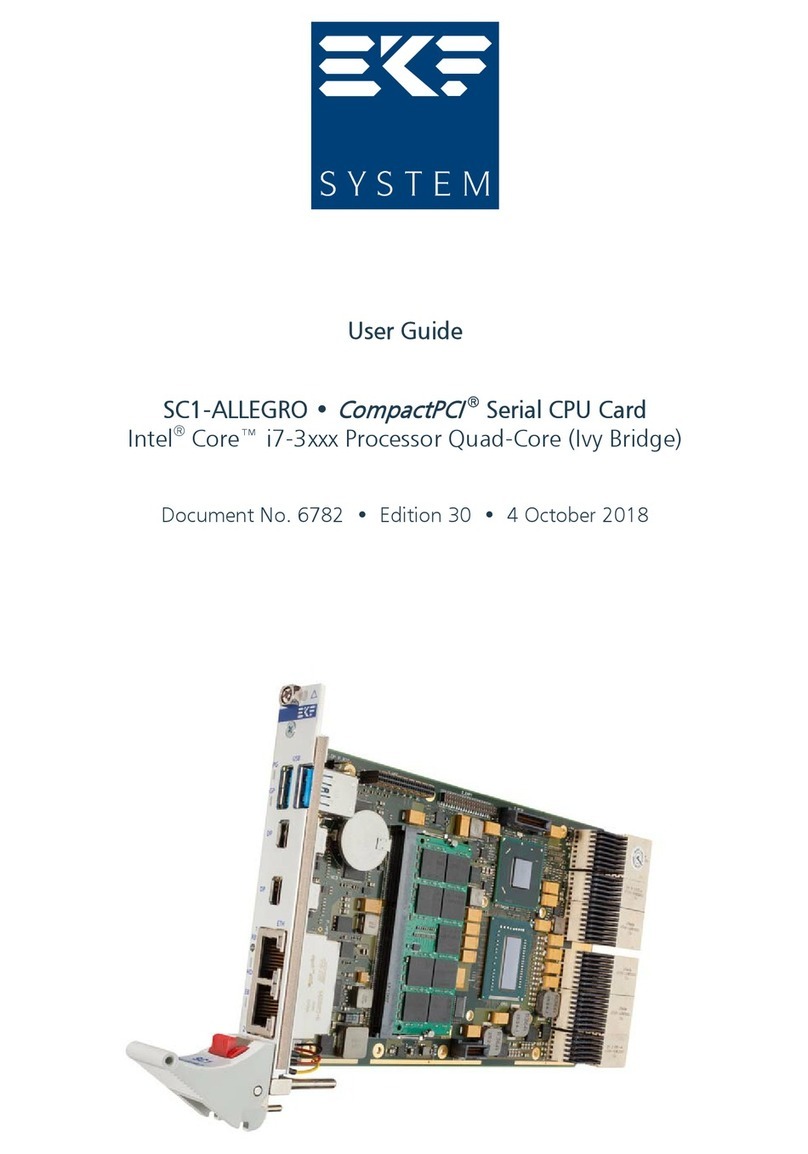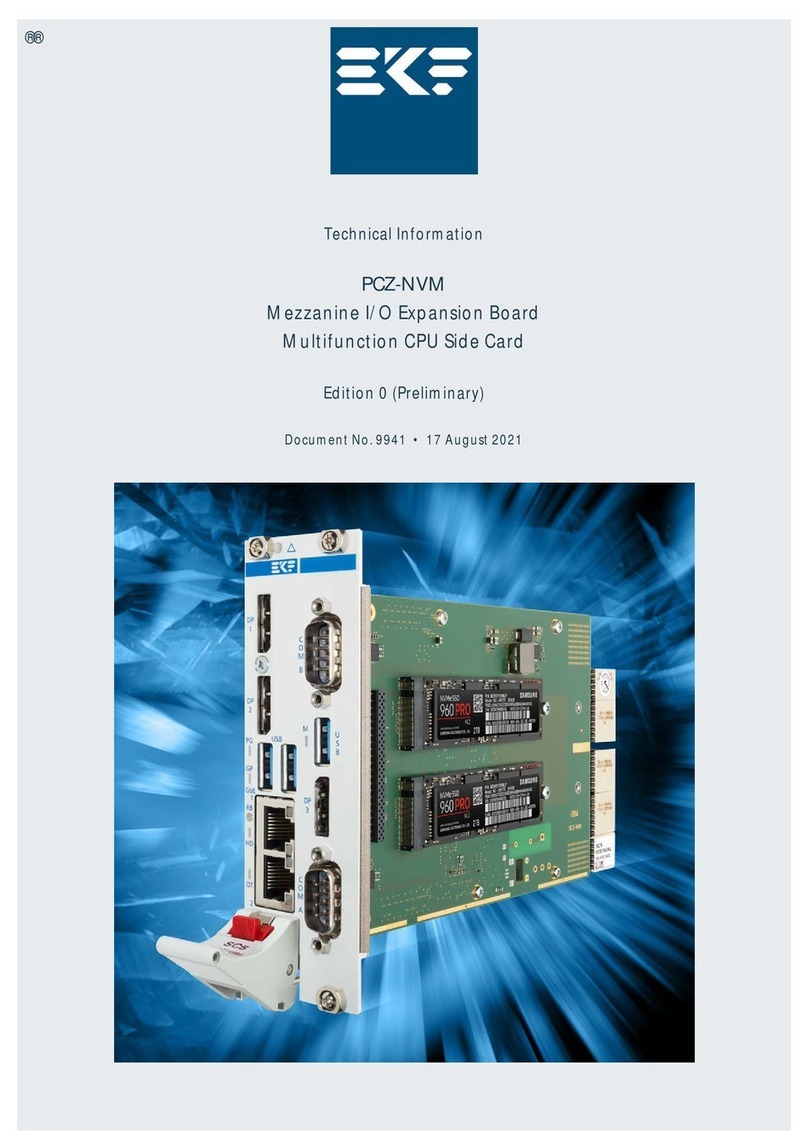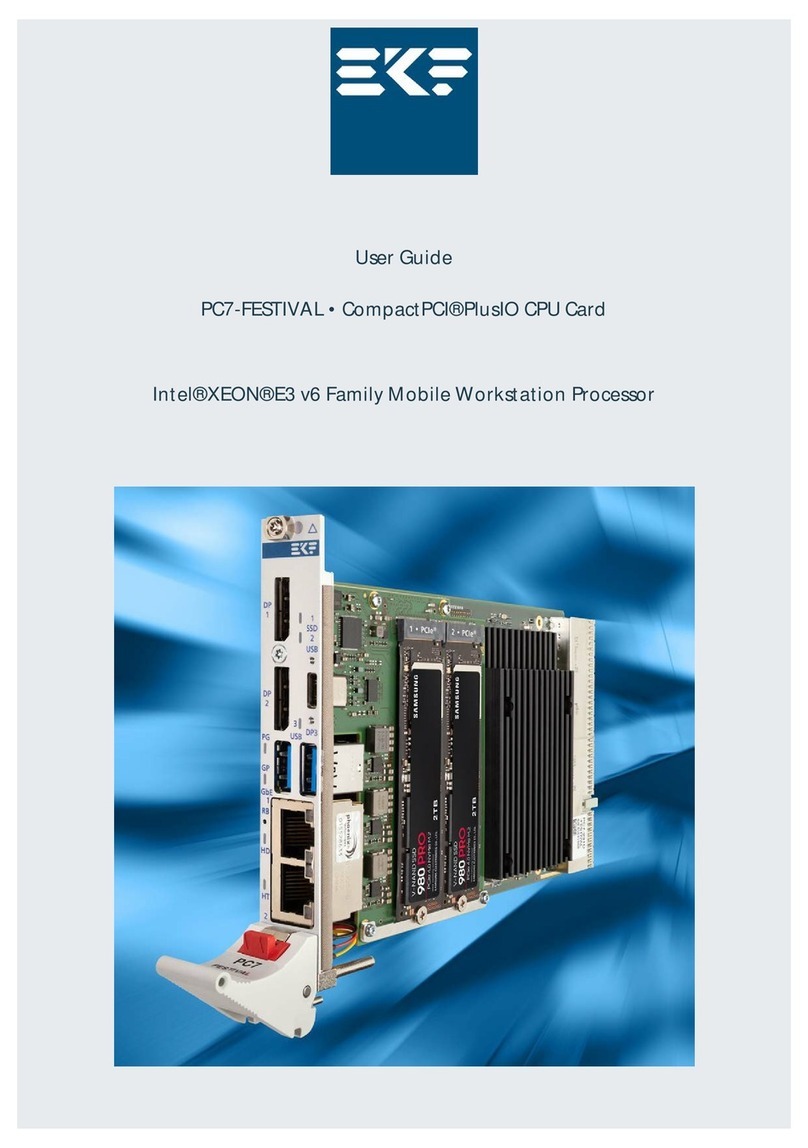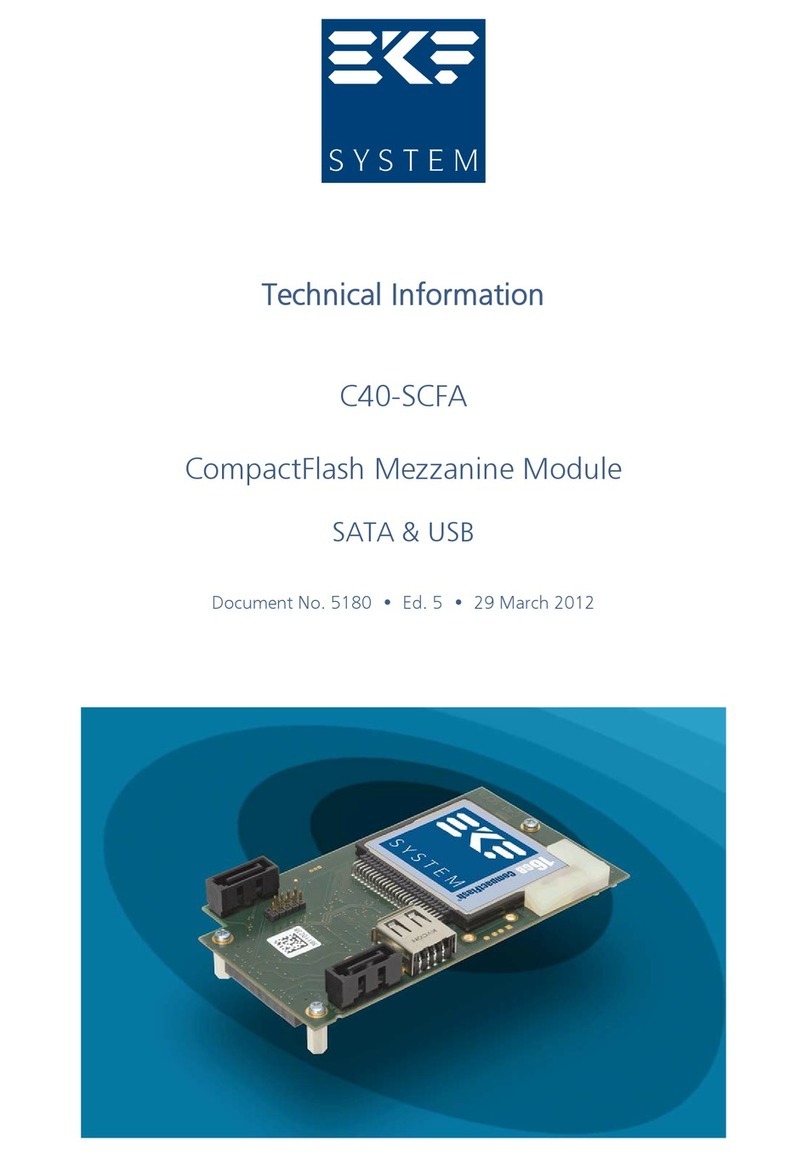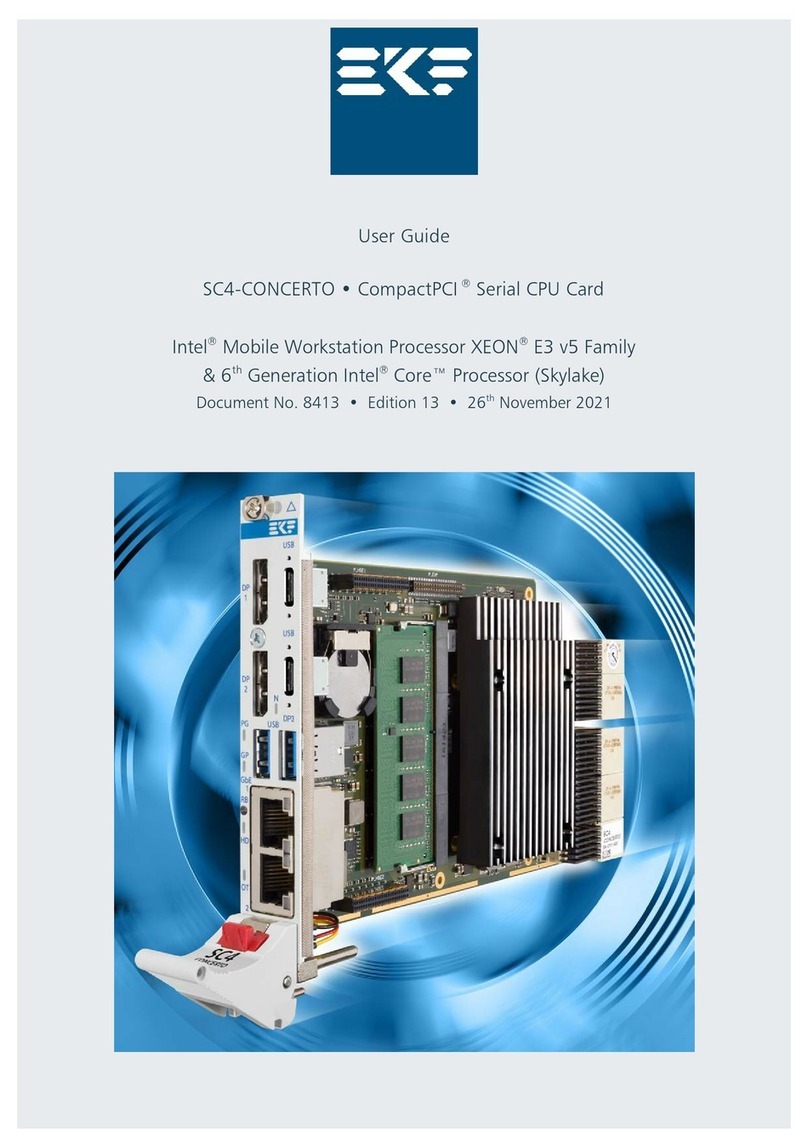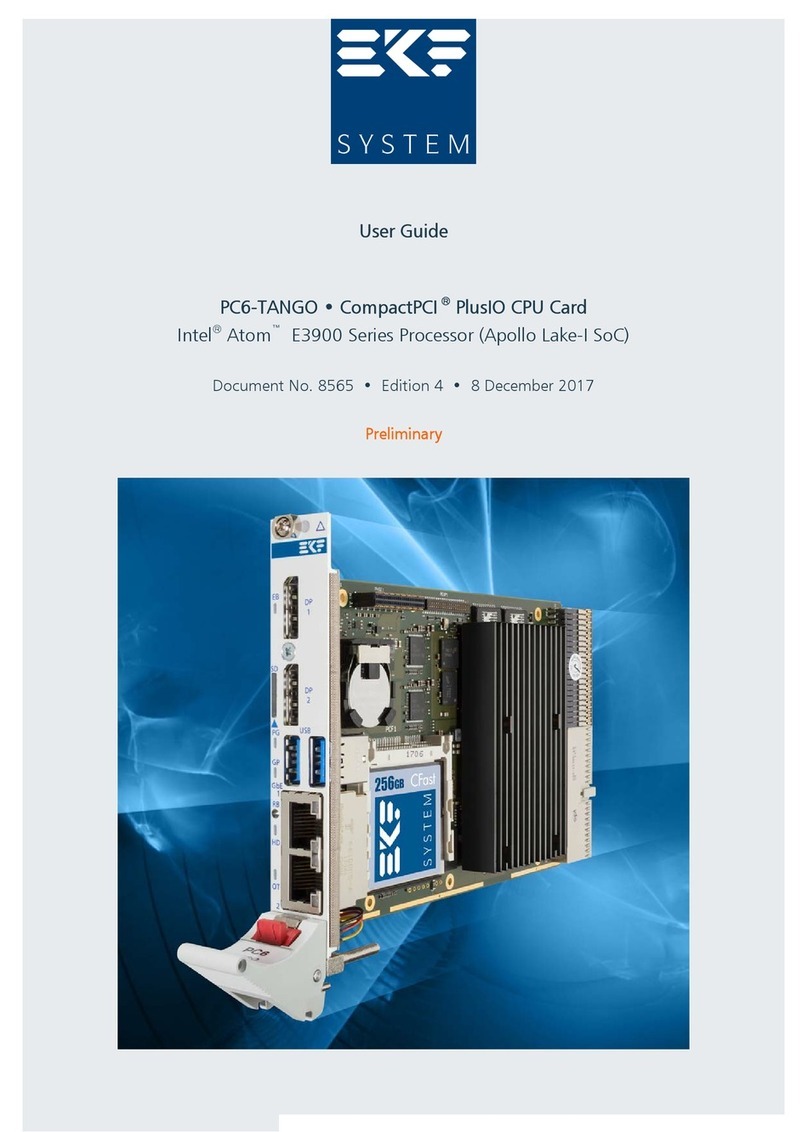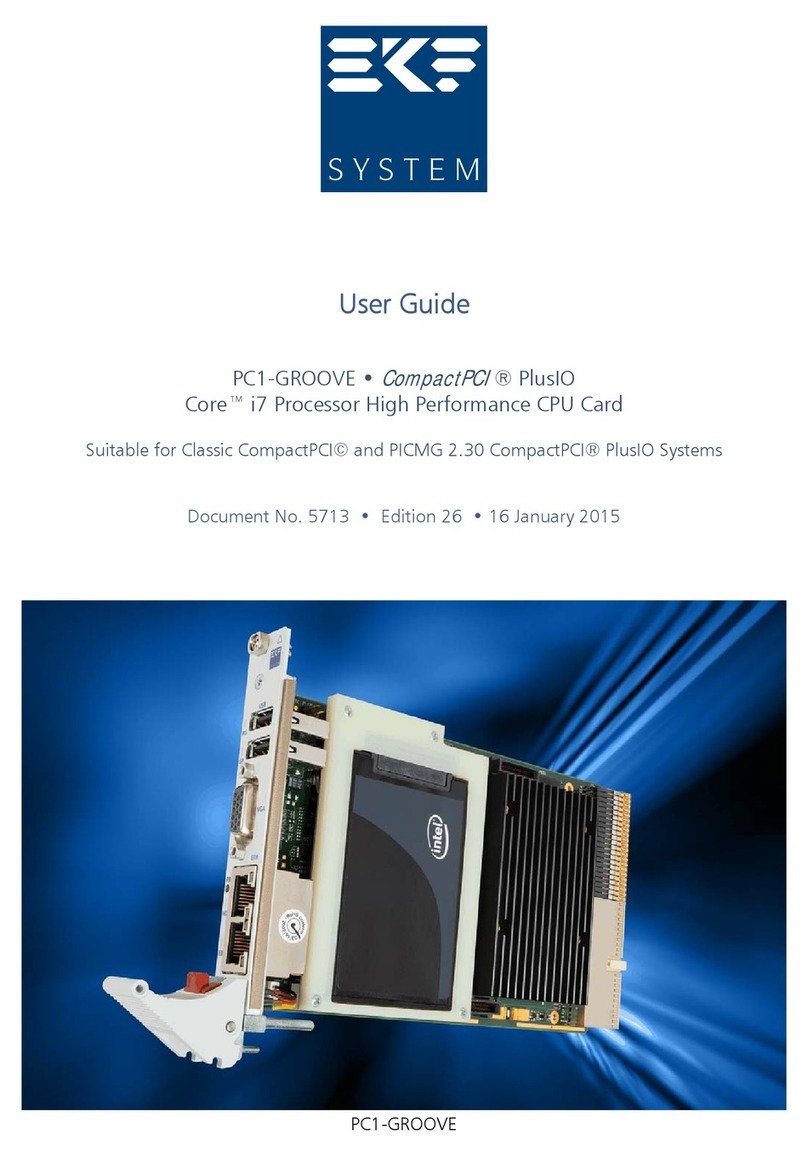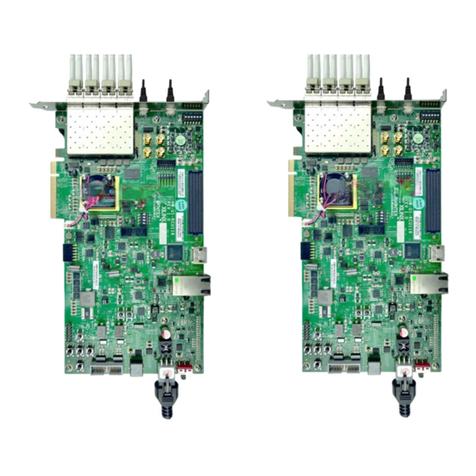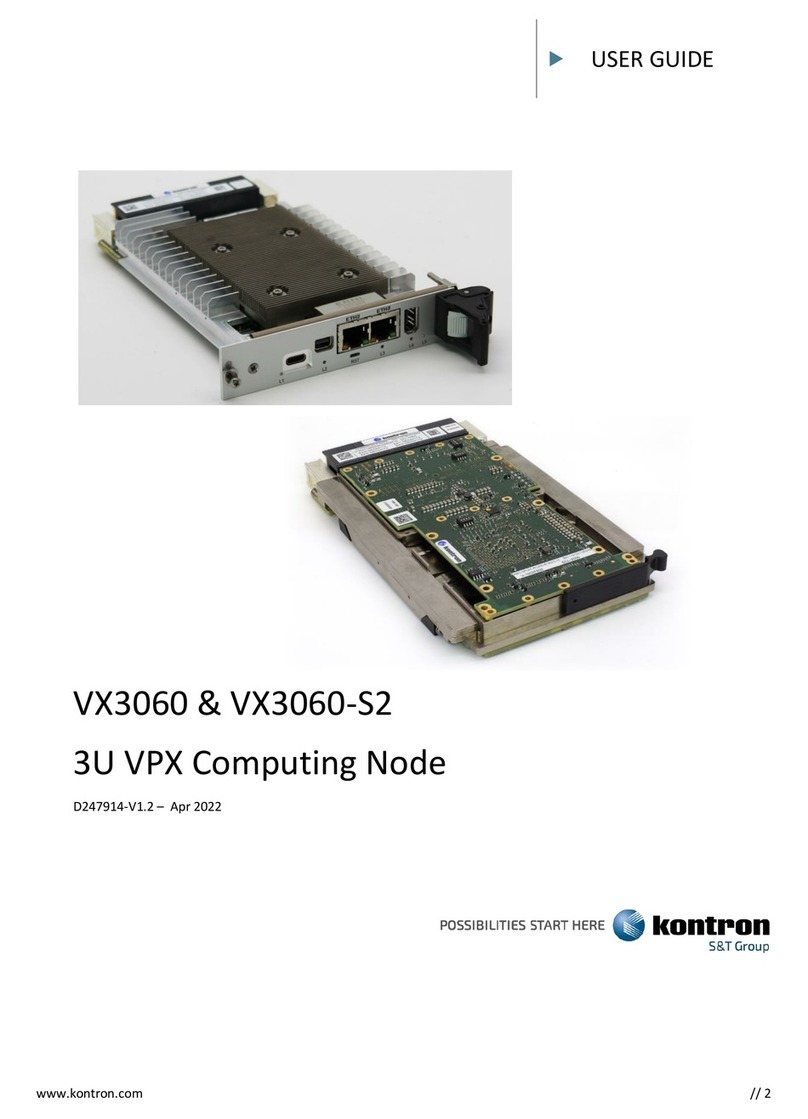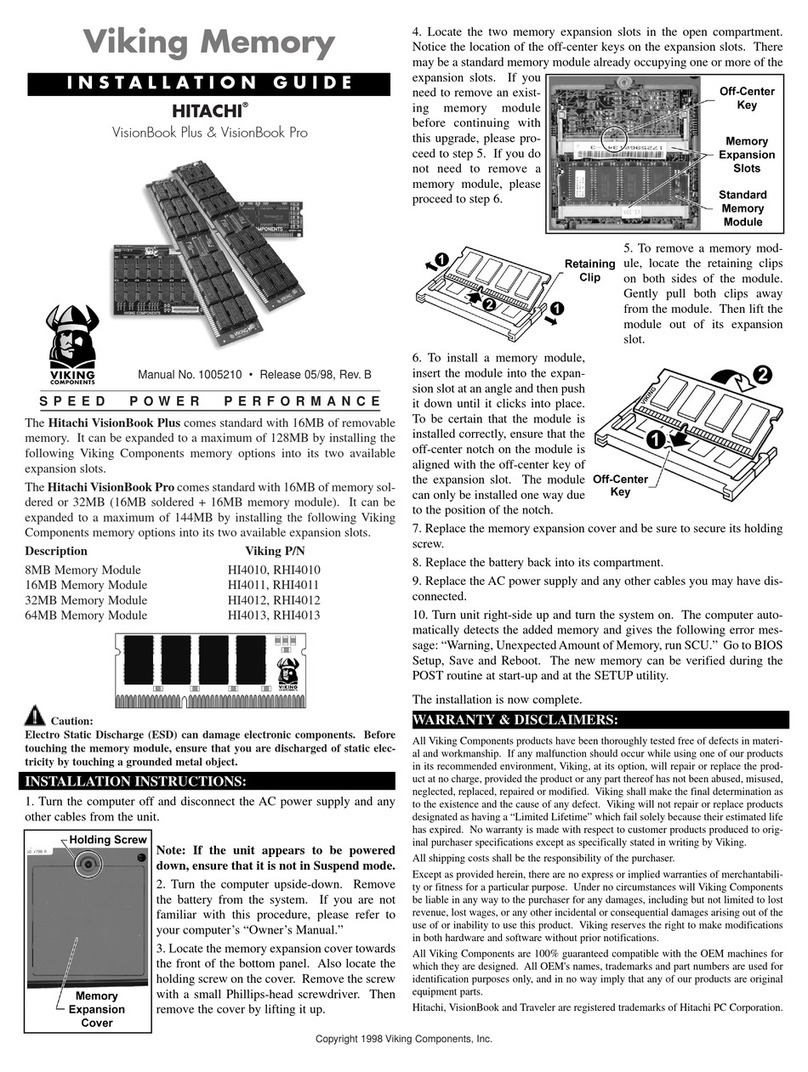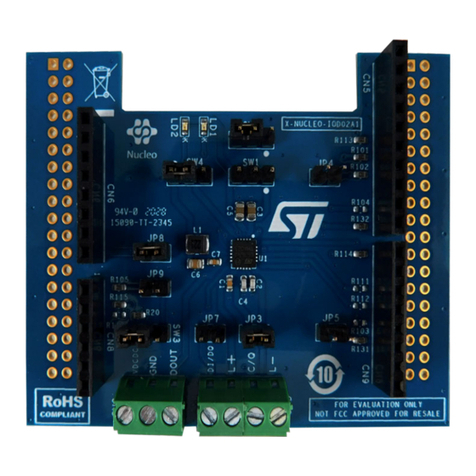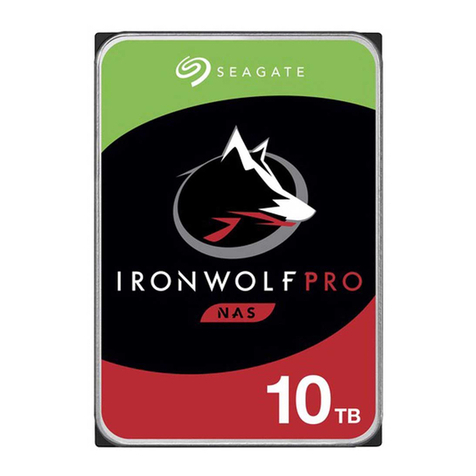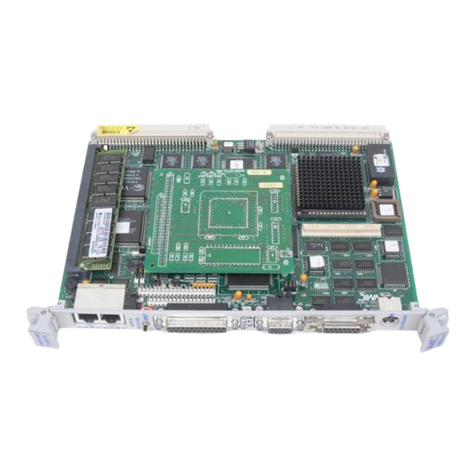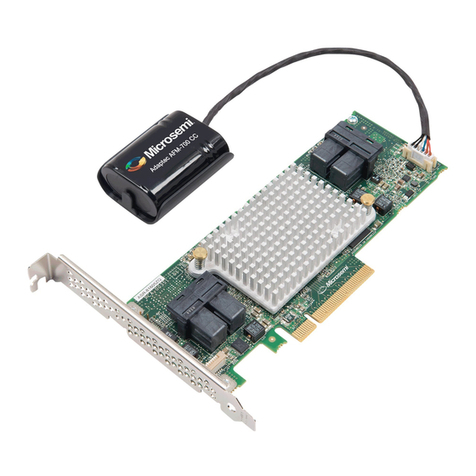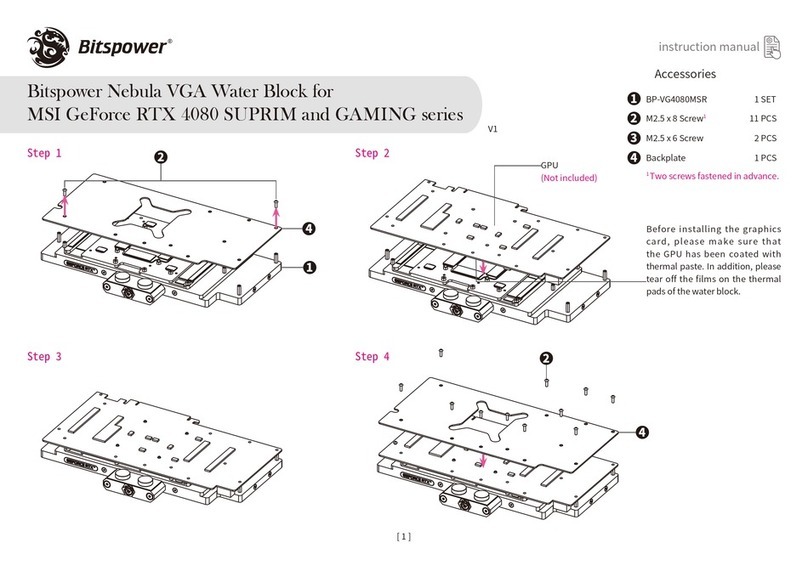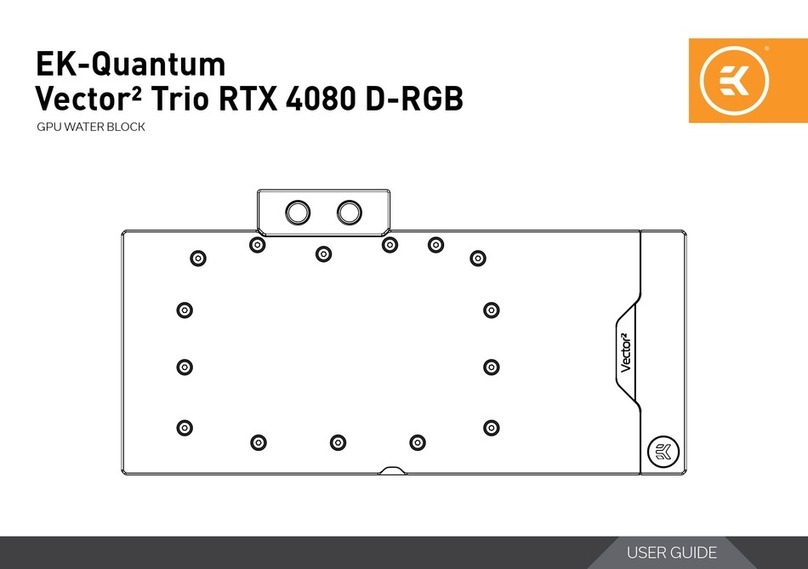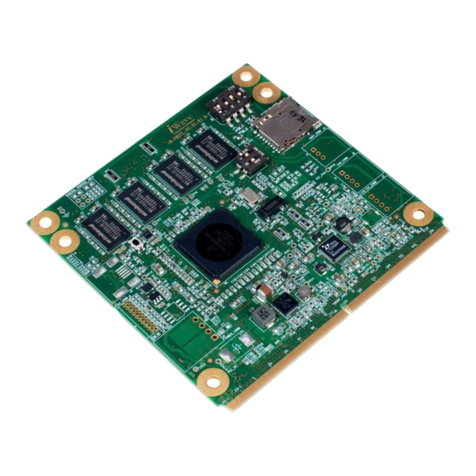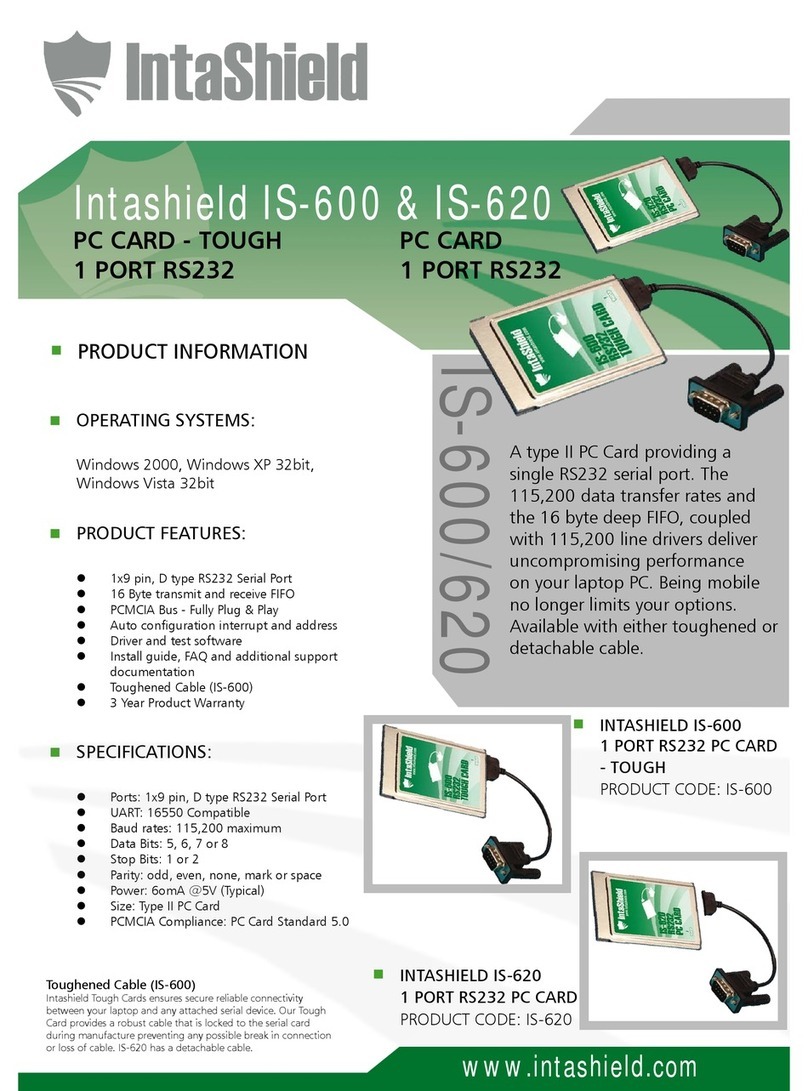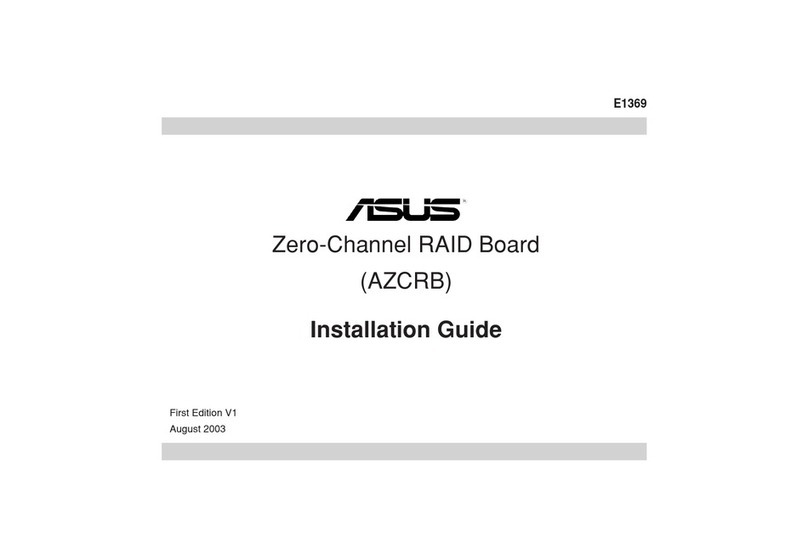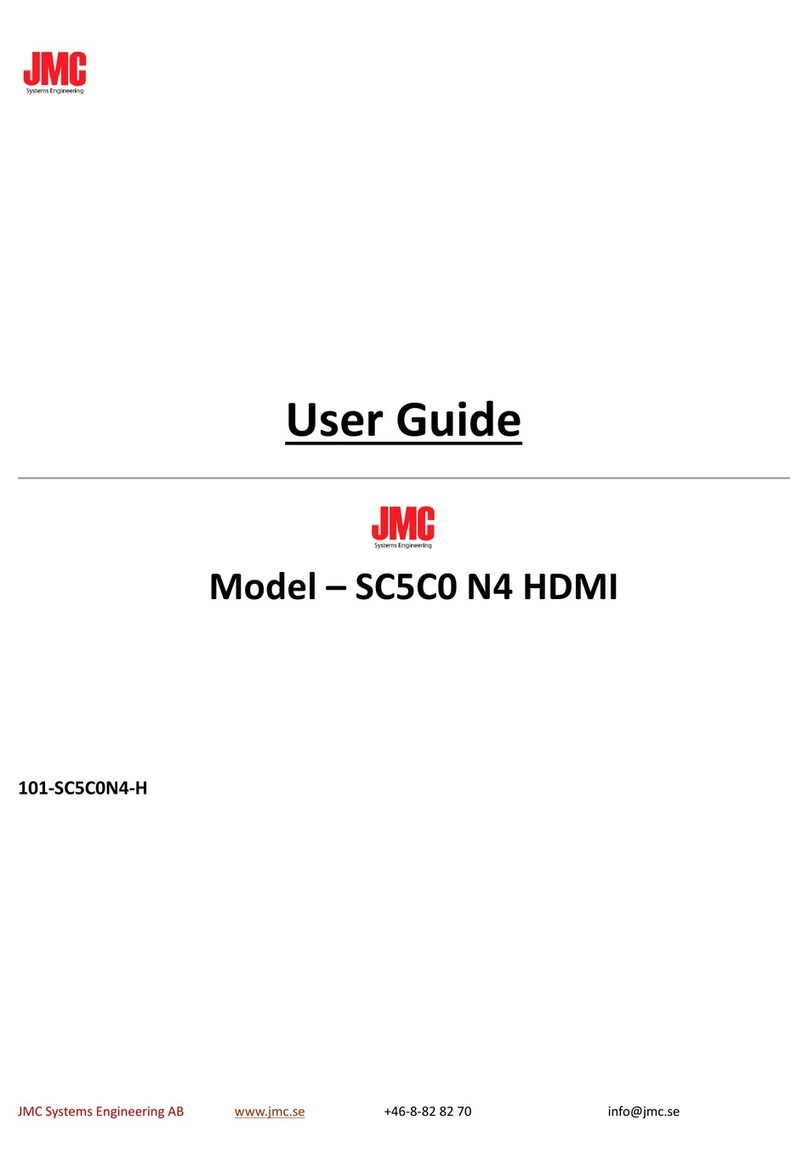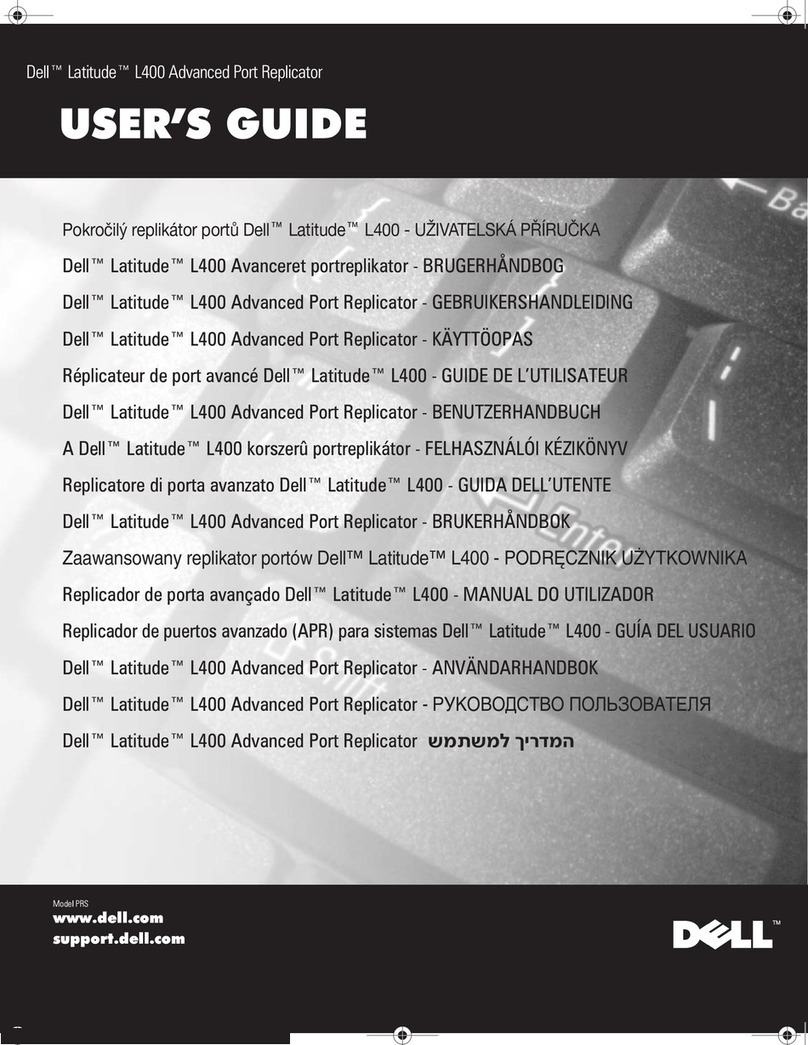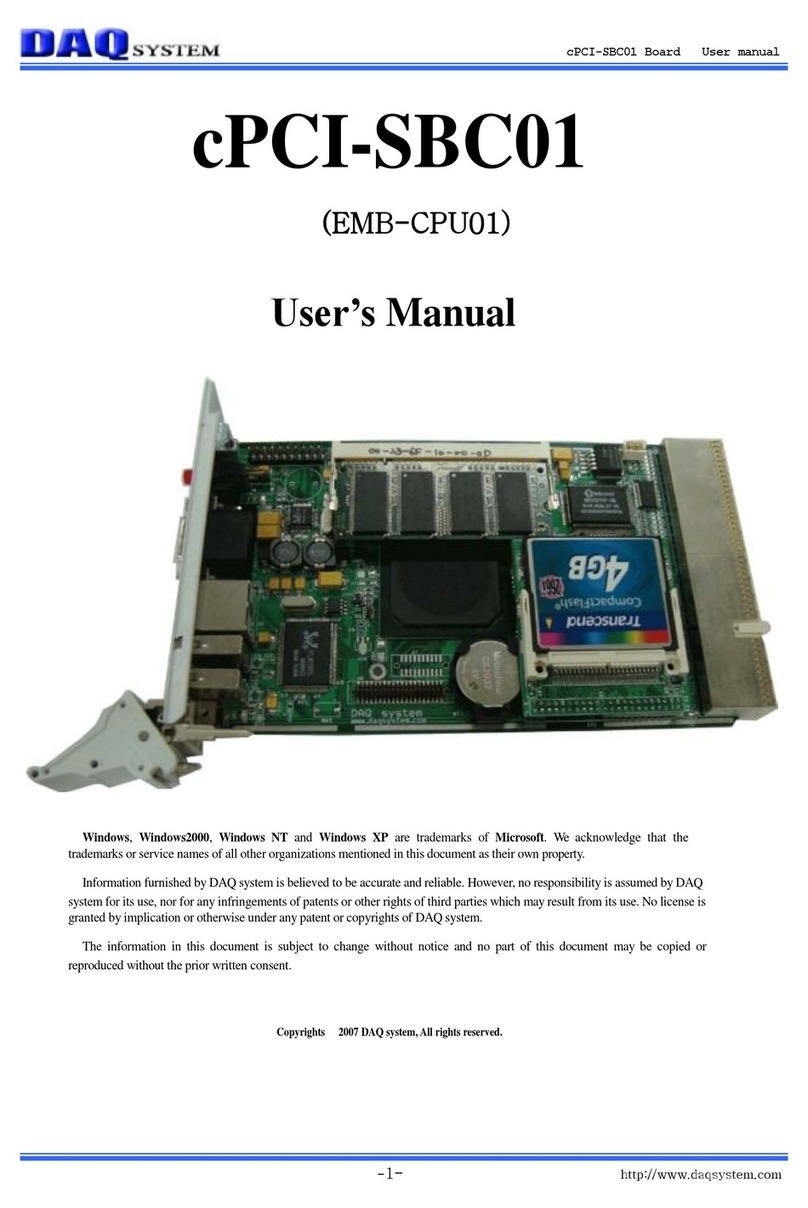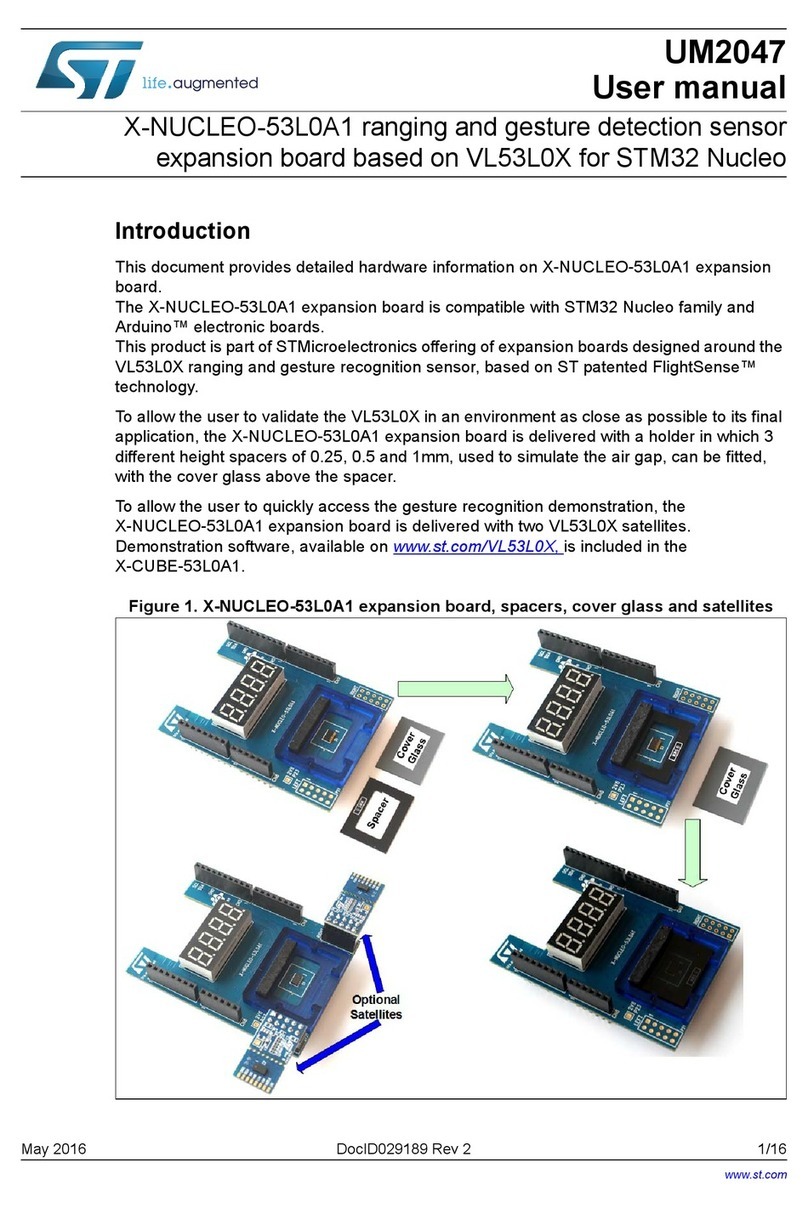EKF PC3-ALLEGRO User manual

User Guide
PC3-ALLEGRO •
CompactPCI
®PlusIO CPU Card
Intel®Core™ i7-3xxx Processor Quad-Core (Ivy Bridge)
Document No. 7106 • Edition 31 • 19 June 2017

User Guide • PC3-ALLEGRO • CompactPCI®PlusIO CPU Board • Intel® i7-3xxx Processor
Contents
AboutthisManual ........................................................... 5
EditionHistory......................................................... 5
RelatedDocuments ..................................................... 6
Nomenclature ......................................................... 6
TradeMarks .......................................................... 6
Legal Disclaimer - Liability Exclusion ......................................... 6
Standards ............................................................ 7
Overview............................................................. 8
TechnicalFeatures .......................................................... 10
FeatureSummary ..................................................... 10
PerformanceRating.................................................... 13
OperatingConditions .................................................. 13
PowerRequirements ................................................... 13
BlockDiagram........................................................ 14
TopViewComponentAssembly .......................................... 15
Front Panel Connectors ................................................. 16
FrontPanelSwitches&Indicators ......................................... 16
On-Board Connectors & Sockets .......................................... 17
PinHeaders .......................................................... 17
Jumpers ............................................................ 17
Microprocessor ....................................................... 18
ThermalConsiderations ................................................. 19
MainMemory ........................................................ 20
GraphicsSubsystem ................................................... 22
LANSubsystem ....................................................... 23
SerialATAInterface(SATA) .............................................. 24
PCIExpress®Interface.................................................. 25
UniversalSerialBus(USB) ............................................... 26
Utility Interfaces ...................................................... 26
Real-TimeClock....................................................... 27
SPIFlash ............................................................ 27
Reset............................................................... 28
Watchdog........................................................... 30
FrontPanelLEDs ...................................................... 31
PG(PowerGood)LED ............................................. 32
GP(GeneralPurpose)LED .......................................... 32
HD(HardDiskActivity)LED ......................................... 33
EB(EthernetBackplane)LED ........................................ 33
Hot Swap Detection ................................................... 34
PowerSupplyStatus(DEG#,FAL#) ........................................ 34
© EKF -2- ekf.com

User Guide • PC3-ALLEGRO • CompactPCI®PlusIO CPU Board • Intel® i7-3xxx Processor
MezzanineSideBoardOptions ........................................... 35
CompactPCI®PlusIO ................................................... 37
InstallingandReplacingComponents............................................ 42
BeforeYouBegin...................................................... 42
InstallingtheBoard .................................................... 43
RemovingtheBoard ................................................... 44
EMCRecommendations................................................. 45
ReplacementoftheBattery .............................................. 46
TechnicalReference ......................................................... 47
LocalPCIDevices ...................................................... 47
LocalSMBDevices ..................................................... 48
Hardware Monitor LM87 ................................................ 49
BoardControlandStatusRegisters ........................................ 50
Write/ReadControlRegister0 ....................................... 51
Read/ClearStatusRegister0 ........................................ 52
Read/ClearStatusRegister1 ........................................ 53
ReadPLDRevisionRegister ......................................... 54
GPIOUsage.......................................................... 55
GPIOUsageQM77PCH ........................................... 55
ConfigurationJumpers ................................................. 57
ConfigurationPCIExpressSwitch(DS-P) ............................... 57
LoadingUEFIBIOSSetupDefaults(P-GP)............................... 59
ManufacturerModeJumper(P-MFG) ................................. 60
RTCReset(P-RTC) ................................................ 61
Connectors .......................................................... 62
Caution ....................................................... 62
Front Panel Connectors ............................................ 63
DisplayPort Connectors ...................................... 64
Screw Locking Option for mDP Connectors ....................... 66
VGA Video Connector ....................................... 69
USB Connectors ............................................ 70
Ethernet Connectors ........................................ 73
Mezzanine Connectors ............................................ 74
ExpansionInterfaceJ-EXP..................................... 75
High Speed Expansion Connector J-HSE .......................... 76
PCIExpress®ExpansionHeaderJ-PCIE ........................... 78
SDVO/DisplayPortExpansionHeaderJ-SDVO ...................... 79
PinHeaders&Debug ............................................. 83
FrontPanelHandleMicroswitchHeaderP-FPH ..................... 83
PLDProgrammingHeaderP-ISP ................................ 84
ProcessorDebugHeaderXDP1................................. 85
© EKF -3- ekf.com

User Guide • PC3-ALLEGRO • CompactPCI®PlusIO CPU Board • Intel® i7-3xxx Processor
Backplane Connectors ............................................. 86
CompactPCI
J1 ........................................ 86
CompactPCI
J2(PlusIO) ...................................... 87
© EKF -4- ekf.com

User Guide • PC3-ALLEGRO • CompactPCI®PlusIO CPU Board • Intel® i7-3xxx Processor
About this Manual
This manual describes the technical aspects of the PC3-ALLEGRO, required for installation and system
integration. It is intended for the experienced user only.
Edition History
Ed. Contents/
Changes
Author Date
1 User Manual PC3-ALLEGRO, english, preliminary edition
Text #7106, File: pc3_ug.wpd
mib 2013-09-09
2 Error corrected on pg.44 , upper and lower table mib 2013-09-25
3 Reworked section “Watchdog” gn 2013-12-06
4 Power Requirements updated mib 2013-12-11
5 Reworked sections Serial ATA Interface and High Speed Expansion
Connector J-HSE
mib 2014-01-10
6 Modified block diagram - RIO SATA configured to 3G by default jj 15 January 2014
7 Table Feature Summary updated jj 17 February 2014
8 Table Power Requirements updated mib 3 April 2014
9 Table CompactPCI J2 updated mib 20 June 2014
10 Added list of local pci devices, SDVO option removed on J-SDVO mib 21 July 2014
11 Added photos PC3 w. PCL Side Card Assembly jj 31 July 2014
12 Added photo PC3 w. PCL Side Card Assembly Exploded View jj 11 August 2014
13 Added ‘Board Control and Status Registers’, updated links mib 21 August 2014
14 Added note on operation in systems with a 64-bit CompactPCI®backplane mib 4 September 2014
15 Added additional function of HD LED mib 18 September 2014
16 Added Power Requirements mib 12 December 2014
17 Clarified resetting of UEFI BIOS settings to factory defaults gn 16 January 2015
18 Universal V(I/O) on CPCI Interface mib 27 January 2015
19 Added power requirements mib 5 February 2015
20 Updated description of BCSR Status Registers 0 and 1, cleanup section
“Watchdog”
gn 7 April 2015
21 Added photos PC3-ALLEGRO with C47-MSATA & C48-M2 jj 27 May 2015
22 Updated LM87 Information mib 28 May 2015
23 Table 'Feature Summary' BIOS replaced by Firmware (UEFI)
Table 'Reference Documents' UEFI & ACPI specifications
jj 14 August 2015
24 Removed redundant Operating Conditions mib 3 September 2015
25 4HP Front panel illustration fixed marking for backplane Ethernet LED = EB,
added 8HP and 12HP front panel illustrations
jj 23 September 2015
26 Table 'Feature Summary', added RT OS support jj 30 September 2015
27 Completed Information about SATA on J-HSE mib 22 January 2016
© EKF -5- ekf.com

User Guide • PC3-ALLEGRO • CompactPCI®PlusIO CPU Board • Intel® i7-3xxx Processor
Ed. Contents/
Changes
Author Date
28 Fixed typo in block diagram regarding J2 PCIe resources jj 29 November 2016
29 Screw locking options for mDP connectors jj 13 December 2016
30 Added Celeron® CPU to table 'Feature Summary' jj 6 April 2017
31 Added photo USB cable connector fixation jj 19 June 2017
Related Documents
Related Information PC3-ALLEGRO
PC3-ALLEGRO Home www.ekf.com/p/pc3/pc3.html
PC3-ALLEGRO Product Information www.ekf.com/p/pc3/pc3_pi.pdf
Nomenclature
Signal names used herein with an attached '#' designate active low lines.
Trade Marks
Some terms used herein are property of their respective owners, e.g.
<Chief River, Ivy Bridge, Panther Point, Core i7: ® Intel
<CompactPCI, CompactPCI PlusIO, CompactPCI Serial: ® PICMG
<Windows XP, Windows 7: ® Microsoft
<EKF, ekf system: ® EKF
EKF does not claim this list to be complete.
Legal Disclaimer - Liability Exclusion
This manual has been edited as carefully as possible. We apologize for any potential mistake.
Information provided herein is designated exclusively to the proficient user (system integrator,
engineer). EKF can accept no responsibility for any damage caused by the use of this manual.
© EKF -6- ekf.com

User Guide • PC3-ALLEGRO • CompactPCI®PlusIO CPU Board • Intel® i7-3xxx Processor
Standards
Reference Documents
Term Document Origin
CFast™ CFast™ Specification Rev. 1.0 www.compactflash.org
CompactPCI
®CompactPCI Specification, PICMG® 2.0 R3.0, Oct. 1, 1999 www.picmg.org
CompactPCI
®
PlusIO
CompactPCI PlusIO Specification, PICMG® 2.30 R1.0,
November 11, 2009
www.picmg.org
CompactPCI
®
Serial
CompactPCI Serial Specification, PICMG® CPCI-S.0 R1.0,
March 2, 2011
www.picmg.org
DisplayPort VESA DisplayPort Standard Version 1.1a
January 11, 2008
VESA Mini DisplayPort Connector Standard Version 1
October 26, 2009
www.vesa.org
DVI Digital Visual Interface Rev. 1.0
Digital Display Working Group
www.ddwg.org
Ethernet IEEE Std 802.3, 2000 Edition standards.ieee.org
LPC Low Pin Count Interface Specification, Revision 1.1 developer.intel.com/design/
chipsets/industry/lpc.htm
HD Audio High Definition Audio Specification Rev.1.0 www.intel.com/design/chipsets/
hdaudio.htm
PCI Express® PCI Express®Base Specification 3.0 www.pcisig.com
SATA Serial ATA 2.5/2.6 Specification
Serial ATA 3.0 & 3.1 Specification
www.sata-io.org
UEFI Unified Extensible Firmware Interface
UEFI Specification Version 2.5
ACPI Specification Version 6.0
www.uefi.org
USB Universal Serial Bus 3.0 Specification, Revision 1.0
November 12, 2008
www.usb.org
© EKF -7- ekf.com

User Guide • PC3-ALLEGRO • CompactPCI®PlusIO CPU Board • Intel® i7-3xxx Processor
Overview
The PC3-ALLEGRO is a rich featured high
performance 4HP/3U CompactPCI
®
PlusIO CPU
board, equipped with a 3
rd
Generation Intel
®
Core™ i7 Ivy Bridge + ECC (dual- or quad-core)
mobile processor based on 22nm technology.
The PC3-ALLEGRO front panel is provided with
two Gigabit Ethernet jacks, two USB 3.0
receptacles, and two Mini-DisplayPort
connectors for attachment of high resolution
digital displays, configured e.g. as extended
desktop (option VGA).
The PC3-ALLEGRO is equipped with up to 16GB
RAM with ECC support. 8GB memory-down are
provided for rugged applications, and another
8GB are available via the DDR3 ECC SO-DIMM
socket. The PC3-ALLEGRO backplane connectors
comply with the PICMG
®
CompactPCI
®
PlusIO
system slot specification, suitable for a rear I/O
module or hybrid CompactPCI
®
Serial Systems.
Several low profile mezzanine modules are
available as mass storage solution.
CompactPCI® PlusIO (PICMG 2.30) is a new
standard for rear I/O across J2, specified by the
PICMG®. High speed signal lines (PCI Express®,
SATA, Gigabit Ethernet and USB) are passed
from the PC3-ALLEGRO through the special
UHM connector to the backplane, for usage
either on a PlusIO rear I/O transition module, or
CompactPCI® Serial card slots.
CompactPCI® Serial (PICMG CPCIS.0) defines a
completely new card slot, based on PCI
Express®, SATA, Gigabit Ethernet and USB
serial data lines. On a hybrid backplane, both
card styles can reside, CompactPCI® and
CompactPCI® Serial, with the PC3-ALLEGRO in
the middle as system slot controller for both
backplane segments.
The PC3-ALLEGRO is equipped with a set of
local expansion interface connectors, which can
be optionally used to attach a mezzanine side
board. A variety of expansion cards is available,
e.g. providing legacy I/O and additional PCI
Express® based I/O controllers such as SATA,
USB 3.0 and Gigabit Ethernet, or a third video
output. Most mezzanine side cards can
accommodate in addition a 2.5-inch drive.
Typically, the PC3-ALLEGRO and the related side
card would come as a readily assembled 8HP
unit. As an alternate, low profile Flash based
mezzanine storage modules are available that
fit on the PC3-ALLEGRO while maintaining the
4HP profile. The C48-M2 module e.g. is
equipped with two M.2 SATA Solid State Drives
(SSD), suitable for installation of any popular
operating system.
© EKF -8- ekf.com

User Guide • PC3-ALLEGRO • CompactPCI®PlusIO CPU Board • Intel® i7-3xxx Processor
© EKF -9- ekf.com

User Guide • PC3-ALLEGRO • CompactPCI®PlusIO CPU Board • Intel® i7-3xxx Processor
Technical Features
Feature Summary
Feature Summary
<CompactPCI® PlusIO (PICMG® CPCI 2.30) System Slot Controller
<J1 Connector for Full CompactPCI® Classic 32-Bit Support, universal V(I/O) (3.3V or 5V)
<J2 Connector (UHM High Speed) for CompactPCI® PlusIO Support
<4 x PCIe
<4 x SATA
<4 x USB
<2 x GbE
<Proven Intel® Mobile CPU Technology
<3rd Generation Intel® Core™ Mobile + ECC CPU, Code Name Ivy Bridge
<i7-3612QE Processor 2.1GHz • 35W TDP Standard Voltage Quad-Core
<i7-3555LE Processor 2.5GHz • 25W TDP Low Voltage Dual-Core
<i7-3517UE Processor 1.7GHz • 17W TDP Ultra Low Voltage Dual-Core
<
i5-3610ME Processor 2.7GHz • 35W TDP Standard Voltage Dual-Core
<i3-3120ME Processor 2.4GHz • 35W TDP Standard Voltage Dual-Core
<i3-3217UE Processor 1.6GHz • 17W TDP Ultra Low Voltage Dual-Core
<Celeron® 1047UE Processor 1.4GHz • 17W TDP Ultra Low Voltage Dual-Core
<Intel®
QM77 Panther Point
Platform Controller Hub (PCH)
<Integrated HD Graphics Engine, 3 Independent Displays, Enhanced Media Processing
<Up to 3 Display Configuration (Front Panel: Dual mDP or Single VGA Connector Option)
<Max Resolution 2560 x 1600 (DisplayPort), 1920 x 1200 (VGA)
<3rd Display via Side Card PCS-BALLET
<Integrated Memory Controller up to 16GB DDR3 +ECC 1600
<DDR3 +ECC Soldered Memory up to 8GB
<DDR3 +ECC SO-DIMM Memory Module Socket up to 8GB
<SATA 6G &3G for Mass Storage
<2 + 2 SATA Channels 6Gbps/3Gbps for Mezzanine Storage Modules (Connector HSE)
<CompactFlash® Card with C40-SCFA Mezzanine Module Option (4HP Maintained)
<CFast™ Card with C41-CFAST Mezzanine Module Option (4HP Profile Maintained)
<SATA 1.8-Inch Solid State Drive with C42-SATA Mezzanine Card Option (4HP Maintained)
<Dual mSATA Modules with C47-MSATA RAID Mezzanine Card Option (4HP Maintained)
<4 x SATA RAID Channels to UHM Connector J2, for RIO Module or CPCI Serial Backplane Usage, limited to
3G SATA by CPCI PlusIO Specification
<Hardware RAID Enabled by Marvell 88SE9230 ARM Powered Subsystem
<RAID Configuration Level 0/1/10
© EKF -10- ekf.com

User Guide • PC3-ALLEGRO • CompactPCI®PlusIO CPU Board • Intel® i7-3xxx Processor
Feature Summary
<USB 3.0 XHCI SuperSpeed & USB 2.0 EHCI Support
<2 x USB 3.0 F/P Connectors
<6 x USB 2.0 to Mezzanine Connectors
<4 x USB 2.0 to J2 (Backplane)
<Gigabit Ethernet Controllers
<2 x GbE F/P RJ-45 Jacks
<2 x GbE to Backplane Connector J2
<PCI Express® Based Design for Component Interconnect
<PCI Express® for System Expansion by Mezzanine and Backplane or RIO
<4 x PCI Express® Gen2 Lanes to CPCI PlusIO Backplane J2 Connector
<4 x PCI Express® Gen2 Lanes to Mezzanine Connector
<Set of Mezzanine Connectors for Storage Module or Side Card
<Legacy I/O Mezzanine Expansion Connector EXP (USB, HD Audio, LPC)
<High Speed I/O Mezzanine Expansion Connector HSE (4 x SATA, 4 x USB)
<PCI Express® Mezzanine Expansion Connector PCIE (4 Lanes)
<Third Display Mezzanine Expansion Connector DP
<Variety of Mezzanine Expansion Boards (Side Cards) Available
<Most Mezzanines Optionally Equipped with 2.5-Inch Single- or Dual-Drive
<Low Profile Storage Modules Maintain 4HP F/P Width
<Side Cards with Additional Front Panel I/O Connectors (8HP & 12HP Assembly
<Phoenix® UEFI (Unified Extensible Firmware Interface) with CSM*
<Fully Customizable by EKF
<Secure Boot on Request
<Windows®, Linux and other (RT)OS' Supported
* CSM (Compatibility Support Module) emulates a legacy BIOS environment, which allows to boot a legacy operating system such
as DOS, 32-bit Windows and some RTOS'
<Best Suited e.g. for Industrial, Transportation & Instrumentation Applications
<Long Term Availability
<Rugged Solution
<Coating, Sealing, Underfilling Available on Request
© EKF -11- ekf.com

User Guide • PC3-ALLEGRO • CompactPCI®PlusIO CPU Board • Intel® i7-3xxx Processor
Feature Summary
<Regulation & Environmental
<RoHS compliant
<EC Regulations EN55022, EN55024, EN60950-1 (UL60950-1/IEC60950-1)
<Operating Temperature: 0°C to +70°C (Industrial Temperature Range on Request)
<Storage Temperature: -40°C to +85°C, max. Gradient 5°C/min
<Humidity 5% ... 95% RH non Condensing
<Altitude -300m ... +3000m
<Shock 15g 0.33ms, 6g 6ms
<Vibration 1g 5-2000Hz
<MTBF 104 x 103h (11.9 years) @ 50°C
<Designed & Manufactured in Germany
<ISO 9001 Certified Quality Management
<RT OS Board Support Packages & Driver
<LynxOS - on request
<On Time RTOS-32 - on request
<OS-9 - on request
<QNX 4.x, 6.x - on request
<Real-Time Linux (RT Patch) - on request
<RTX - on request
<VxWorks 6.9 - under development
<VxWorks 7.0 - on request
<Others - on request
© EKF -12- ekf.com

User Guide • PC3-ALLEGRO • CompactPCI®PlusIO CPU Board • Intel® i7-3xxx Processor
Performance Rating
Performance Rating
tbd
Operating Conditions
Operating Conditions
Thermal &
Environmental
Conditions
<Operating Temperature 0°C to +70°C (-40°C to +85°C on Request)
<Storage temperature: -40°C to +85°C, max. Gradient 5°C/min
<Humidity 5% ... 95% RH non Condensing
<Altitude -300m ... +3000m
<Shock 15g 0.33ms, 6g 6ms
<Vibration 1g 5-2000Hz
EC Regulations <EN55022, EN55024, EN60950-1 (UL60950-1/IEC60950-1)
<2002/95/EC (RoHS)
MTBF 104 x 103h (11.9 years) @ 50° C
Power Requirements
Power Requirements
Board
Load Current [A] at +3.3V (+0.17V/-0.1V) Load Current [A] at +5V (+0.25V/-0.15V)
Maximum Performance
LFM / HFM / Turbo 1)
Windows 7 Idle
LFM / HFM / Turbo 1)
Maximum Performance
LFM / HFM / Turbo 1)
Windows 7 Idle
LFM / HFM / Turbo 1)
PC3-68XX 5.0 / 5.0 / 5.0 2) 2.7 / 2.7 / 2.7 2) 6.9 / 7.1 / 8.7 0.8 / 0.8 / 0.8
PC3-48XX 4.1 / 4.1 / 4.1 2) 2.7 / 2.7 / 2.7 2) 4.3 / 5.1 / 5.5 0.8 / 0.8 / 0.8
PC3-22XX TBD / TBD / TBD 2) TBD / TBD / TBD 2) TBD / TBD / TBD TBD / TBD / TBD
PC3-046X 3) - / 2.65 / - 2) 1.9 / 1.9 / - 2) - / 2.45 / - 0.7 / 0.7 / -
1) Intel SpeedStep Frequence Modes LFM: Low Frequency Mode, HFM: High Frequency Mode.
2) Add 200/600mA (link only/active) @1Gbps per Ethernet Port.
3) For Intel Celeron-1047UE there is no Turbo Mode at all and no low Frequency Mode at workload.
© EKF -13- ekf.com

User Guide • PC3-ALLEGRO • CompactPCI®PlusIO CPU Board • Intel® i7-3xxx Processor
Block Diagram
Simplified Block Diagram
PC3-ALLEGRO
PICMG CompactPCI PlusIO
®®
CPU Card
32
Backplane
CompactPCI
PlusIO
2
J1
PCI
33/66MHz
VGA
Front
Panel
I/O
GbE
1
DP1
Front Panel Stuffing Alternates -
either Mini DisplayPort or VGA
USB3
82579
LM
SPI
Flash
GbE
2
PCIe
PCIe
SPI
2
DP2
GbE
GbE
Intel® Chief River Platform
82574
IT
DDR3 ECC Soldered
DDR3 ECC SODIMM
FDI
DDR3 1333/1600
Dual Channel
up to 16GB
4
PCIe
Gen3
1
PCIe
Gen3
DP3
Mezzanine
Side
Card
I
/
O
PCIe
Gen2
Switch
USB2
8608
6
LPC/Audio/SMB/GPIO
4
2
DMI2
4 x 5GT/s
4
2
4
SATA 6G/3G
2/2
GbE
2
SATA
RAID
USB2
4
PCIe
PCIe Gen2
PCIe
Gen2
QM77
Mobile
PCH
Panther
Point
Ivy
Bridge
ECC
Embedded
Mobile
CPU
2/4-Core
PCIe
to
PCI
Bridge
4
PCI
PCIe Gen3
8112
9230 4
82574
IT
configured
to
SATA
3G
by
default
according
to
CPCI
PlusIO
specification
© EKF -14- ekf.com

User Guide • PC3-ALLEGRO • CompactPCI®PlusIO CPU Board • Intel® i7-3xxx Processor
Top View Component Assembly
PC3-ALLEGRO
© EKF • ekf.com
Ivy Bridge
i7
CPU
2 Channel ECC DDR3
SODIMM ECC DDR3
SDVO/DP
PCIE
EXP
HSE
PC3-ALLEGRO CompactPCI® PlusIO • © EKF • ekf.com•
Dual
GbE
VGA
P-GP
P-FPH
P-RTC
BAT
P-MFG
1
1
1
1
DP
2
DP
1
2 x
USB
3.0
QM77
PCH
Mobile
Soldered ECC DDR3
J1
J2
UHM
J2
UHM
© EKF -15- ekf.com

User Guide • PC3-ALLEGRO • CompactPCI®PlusIO CPU Board • Intel® i7-3xxx Processor
Front Panel Connectors
ETH1/2 Dual Gigabit Ethernet RJ-45 receptacles with integrated indicator LEDs
mDP1/2 Mini DisplayPort digital video output receptacle (VGA connector available as
alternate)
USB1/2 Universal Serial Bus 3.0 type A receptacles
VGA VGA analog video output connector (Mini DisplayPort connectors available as
alternate)
Front Panel Switches & Indicators
EB LED indicating Backplane Ethernet activity
FPH Front Panel Handle with integrated switch (programmable function, power event
button by default)
GP General Purpose bicolour LED
HD LED indicating any activity on SATA ports
PG Power Good/Board Healthy bicolour LED
RST System Reset Button (Option)
© EKF -16- ekf.com

User Guide • PC3-ALLEGRO • CompactPCI®PlusIO CPU Board • Intel® i7-3xxx Processor
On-Board Connectors & Sockets
J-EXPT
J-EXPB 1)
Utility EXPansion Interface Connector (LPC, USB, HD Audio, SMBus), available either
from top (T) or bottom (B) 1) of the board, interface to optional side board
J-HSE High Speed Expansion Connector (4 x SATA, 4 x USB), interface to optional low
profile mezzanine module or side board
J-PCIE PCI Express® Expansion Interface Connector, interface to optional side board
J-SDVO Digital Display Interface Connector (DisplayPort)
J1/J2
CompactPCI
Bus 32-bit (universal V(I/O)), 33MHz, PlusIO
SODM1 204-pin DDR3 ECC Memory Module SDRAM PC3-12800 Socket (ECC SODIMM)
XDP CPU Debug Port 1)
1) Connector populated on customers request only
Pin Headers
P-FPH Pin header suitable for Front Panel Handle switch cable harness
P-ISP PLD glue logic device programming connector, not populated
Jumpers
DS-P Switches to configure link width and speed on J-PCIE
P-GP Jumper to reset UEFI BIOS Setup to EKF Factory Defaults
P-MFG Jumper to enter Manufacturing Mode, not populated
P-RTC Jumper to reset RTC circuitry (part of PCH), not populated
© EKF -17- ekf.com

User Guide • PC3-ALLEGRO • CompactPCI®PlusIO CPU Board • Intel® i7-3xxx Processor
Microprocessor
The PC3-ALLEGRO is equipped with Intel® CoreTM i7 or i5 3rd generation mobile ECC processor (code
name Ivy Bridge). These low power processors provide integrated graphics and memory controller,
which results in a very efficient platform design. The CoreTM processors almost can be considered as
a single-chip solution, since all functions of a typical north-bridge have been moved to the CPU.
The CoreTM i7 and i5 processor family includes beside the Standard-Voltage (SV) also several Ultra
Low-Voltage (ULV) and Low-Voltage (LV) processors as listed below. The processors are housed in a
Micro FC-BGA package for direct soldering to the PCB, i.e. the chip cannot be removed or changed by
the user.
The processors supported by the PC3-ALLEGRO are running at core clock speeds up to 2.1GHz for
quad core and up to 2.5GHz on dual core devices. Due to Enhanced Intel® SpeedStep® and Intel®
Turbo Boost Technology each core can decrease or increase its nominal operating frequency. The
clock speed is chosen depending on the power states of the processor cores/graphics engine, the
currently required performance, and the actual core temperature.
Power is applied across the
CompactPCI
connectors J1 (3.3V, 5V). The processor core voltage is
generated by a switched voltage regulator, sourced from the 5V plane. The processor signals its
required core voltage by 7 dedicated pins according to Intels IMVP-7 voltage regulator specification.
Intel® CoreTM Processors Supported
Processor
Number
Physical
Cores
Core Clock
nom./max.
Cache Gfx
Clock
Junction
Temp.
TDP CPU ID Stepping SPEC
Code
i7-3612QE 4 2.1/3.1GHz 4MB 650MHz +105°C 35W 306A9h E-1 SR0ND
i7-3555LE 2 2.5/3.2GHz 4MB 550MHz +105°C 25W 306A9h L-1 SR0T5
i7-3517UE 2 1.7/2.8GHz 4MB 350MHz +105°C 17W 306A9h L-1 SR0T6
i5-3610ME 2 2.7/3.3GHz 3MB 650MHz +105°C 35W 306A9h L-1 SR0QK
© EKF -18- ekf.com

User Guide • PC3-ALLEGRO • CompactPCI®PlusIO CPU Board • Intel® i7-3xxx Processor
Thermal Considerations
In order to avoid malfunctioning of the PC3-ALLEGRO, take care of appropriate cooling of the processor and
system, e.g. by a cooling fan suitable to the maximum power consumption of the CPU chip actually in use. The
processor contains digital thermal sensors (DTS) that are readable via special CPU registers. DTS allows to get
the temperatures of each CPU core separately.
Two further temperature sensors, located in the system hardware monitor LM87, allows for acquisition of the
boards surface temperature and the thermal state of the onboard system memory channel. Beside this the
LM87 also monitors most of the supply voltages. A suitable software on Microsoft Windows® systems to
display both, the temperatures as well as the supply voltages, is Speedfan, which can be downloaded from the
web. After installation, both temperatures and voltages can be observed permanently from the Windows®
taskbar.
The PC3-ALLEGRO is equipped with a passive heatsink. Its height takes into account the 4HP limitation in
mounting space of a
CompactPCI
®board. In addition, a forced vertical airflow through the system enclosure
(e.g. bottom mount fan unit) is strongly recommended (>20m3/h or 2m/s (400LFM) around the CPU slot). Be
sure to thoroughly discuss your actual cooling needs with EKF. Generally, the faster the CPU speed the higher
its power consumption. For higher ambient temperatures, consider increasing the forced airflow to 3m/s
(600LFM) or more.
The table showing the supported processors above give also the maximum power consumption (TDP = Thermal
Design Power) of a particular processor. Fortunately, the power consumption is by far lower when executing
typical Windows® or Linux tasks. The heat dissipation increases when e.g. rendering software like the Acrobat
Distiller is executed.
The CoreTM i7 processors support Intel's Enhanced SpeedStep® technology. This enables dynamic switching
between multiple core voltages and frequencies depending on core temperature and currently required
performance. The processors are able to reduce their core speed and core voltage in multiple steps down to
1200MHz (800MHz for LV/ULV processors). Additional a reduction of the graphics core clock and voltage is
possible. This leads to an obvious reduction of power consumption resulting in less heating. This mode of
lowering the processor core temperature is called TM2 (TM=Thermal Monitor).
Another way to reduce power consumption is to modulate the processor clock. This mode (TM1) is achieved by
actuating the 'Stop Clock' input of the CPU. A throttling of 50% e.g. means a duty cycle of 50% on the stop
clock input. However, while saving considerable power consumption, the data throughput of the processor is
also reduced. The processor works at full speed until the core temperature reaches a critical value. Then the
processor is throttled by 50%. As soon as the high temperature situation disappears the throttling will be
disabled and the processors runs at full speed again.
These features are controllable by BIOS menu entries. By default the BIOS of the PC3-ALLEGRO enables mode
TM2 which is the most efficient.
© EKF -19- ekf.com

User Guide • PC3-ALLEGRO • CompactPCI®PlusIO CPU Board • Intel® i7-3xxx Processor
Main Memory
The PC3-ALLEGRO features two channels of DDR3 SDRAMs with support of ECC (Error Correction
Code). One channel is realized with 18 memory devices soldered to the board (Memory Down) and
delivers a capacity of up to 8GB with a clock frequency of 1600MHz (PC3-12800).
The 2nd channel provides a socket for installing a 204-pin ECC SODIMM module thus allowing a
simple expansion of system memory (max. module height = 1.25 inch). Supported are unbuffered
DDR3 ECC SODIMMs (72-bit) with VDD=1.5V featuring on-die termination (ODT), according the
PC3-12800 specification. Minimum module size is 512MB; maximum module size is 8GB. Please note
that standard DDR3 SODIMMs without ECC feature do not work on PC3-ALLEGRO.
It is recommended to add a SODIMM module with same size as the Memory Down to get best
performance (some of the system memory is dedicated to the graphics controller). This typically results
in a size of 2x4GB of memory which is recommended to run the operating systems Windows® Vista
or Windows® 7.
The memory controller supports symmetric and asymmetric memory organization. The maximum
memory performance can be obtained by using the symmetric mode. When in this mode, the memory
controller accesses the memory channels in an interleaved way. Since CoreTM i7 processors support
Intels Flex Memory Technology, interleaved operation isn't limited to systems using memory channels
of equal capacity. In the case of unequal memory population the smaller memory channel dictates the
address space of the interleaved accessible memory region. The remainder of the memory is then
accessed in non-interleaved mode.
In asymmetric mode the memory always will be accessed in a non-interleaved manner with the
drawback of less bandwidth. The only meaningful application of asymmetric mode is the special case
when only one memory channel is populated (i.e. the SODIMM socket may be left empty).
The contents of the SPD EEPROM on the SODIMM is used by the BIOS at POST (Power-on Self Test) to
get any necessary timing parameters to program the memory controller within the chipset.
© EKF -20- ekf.com
Table of contents
Other EKF Computer Hardware manuals
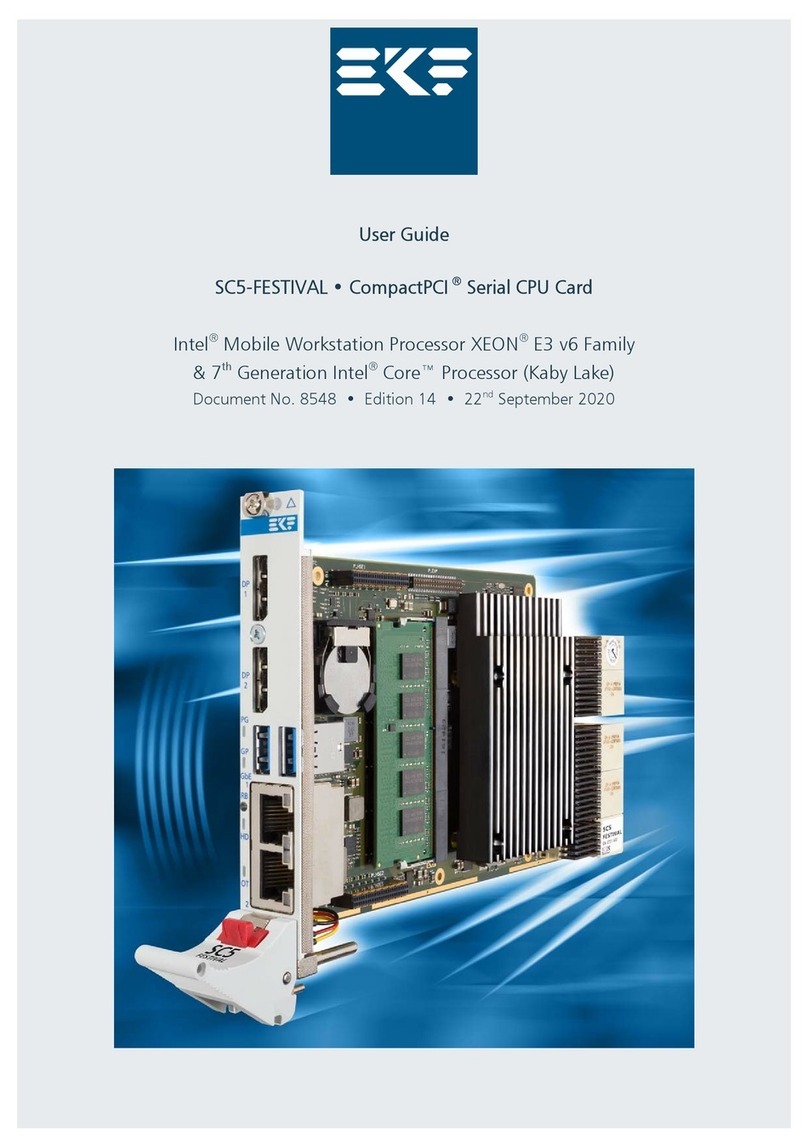
EKF
EKF CompactPCI SC5-FESTIVAL User manual
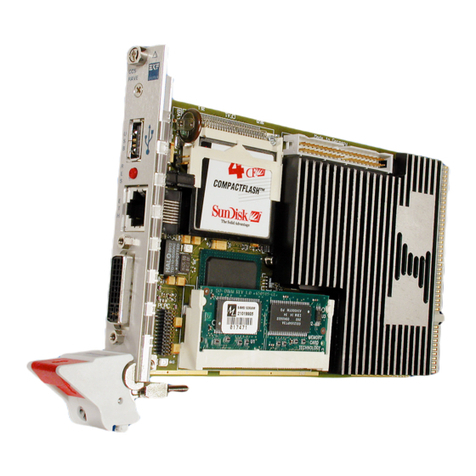
EKF
EKF CompactPCI CC5-RAVE User manual
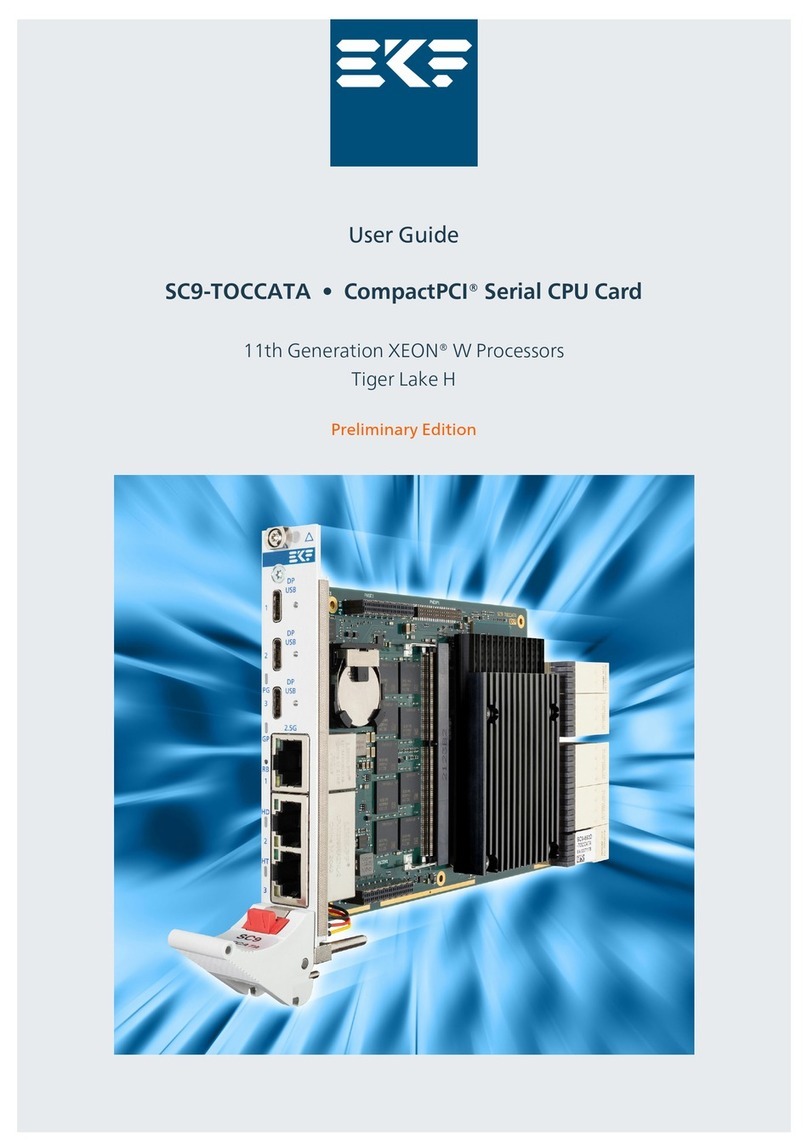
EKF
EKF SC9-TOCCATA User manual
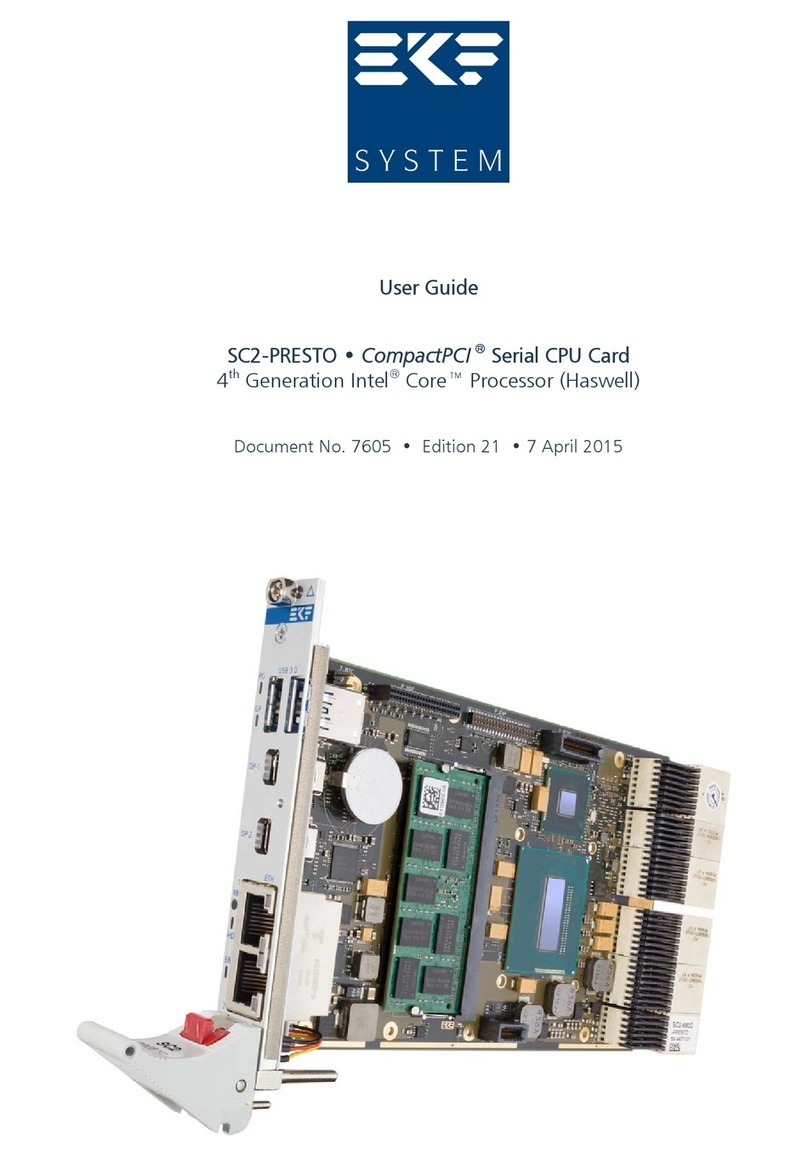
EKF
EKF SC2-PRESTO CompactPCI User manual
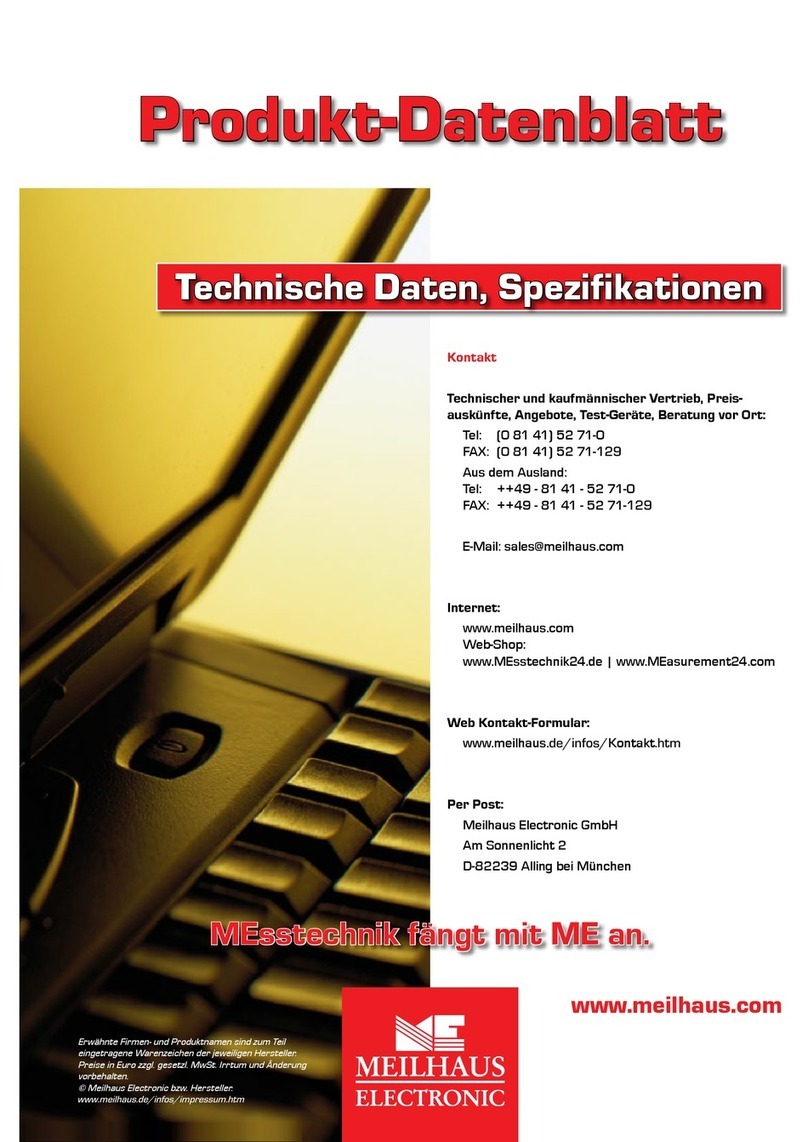
EKF
EKF CompactPCI CCM-BOOGIE User manual
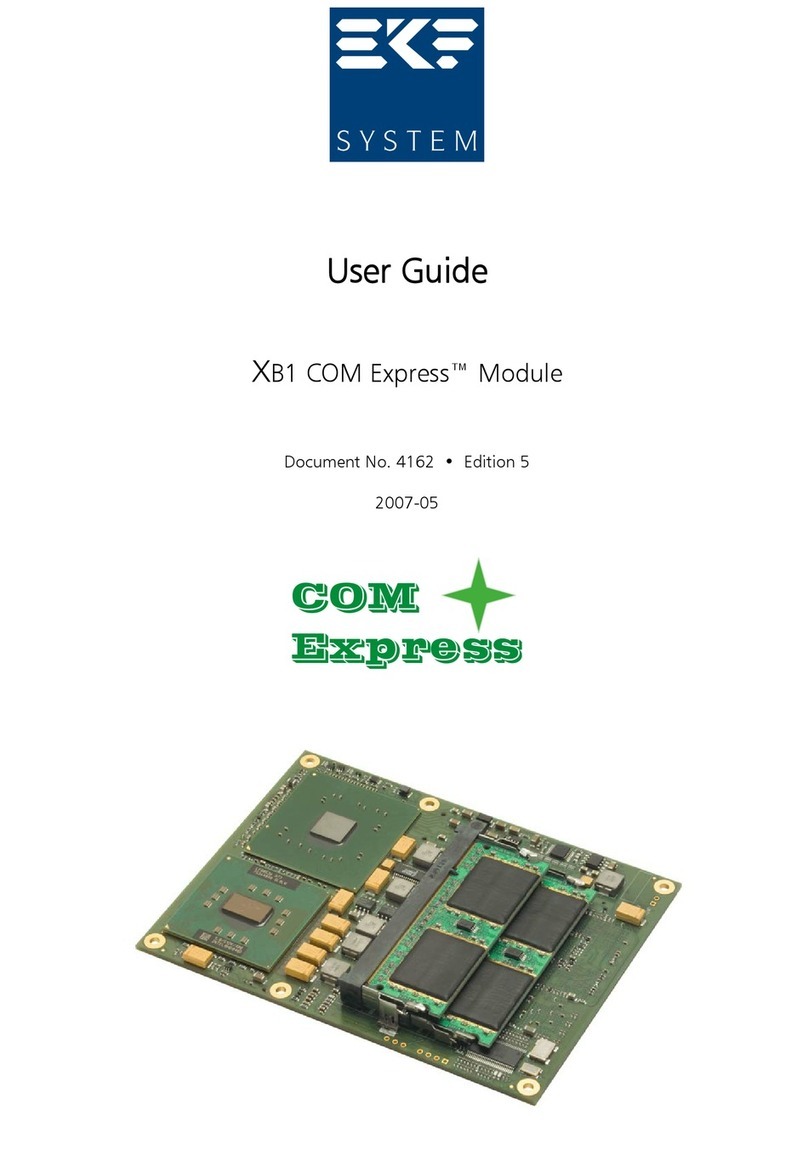
EKF
EKF 82600 User manual
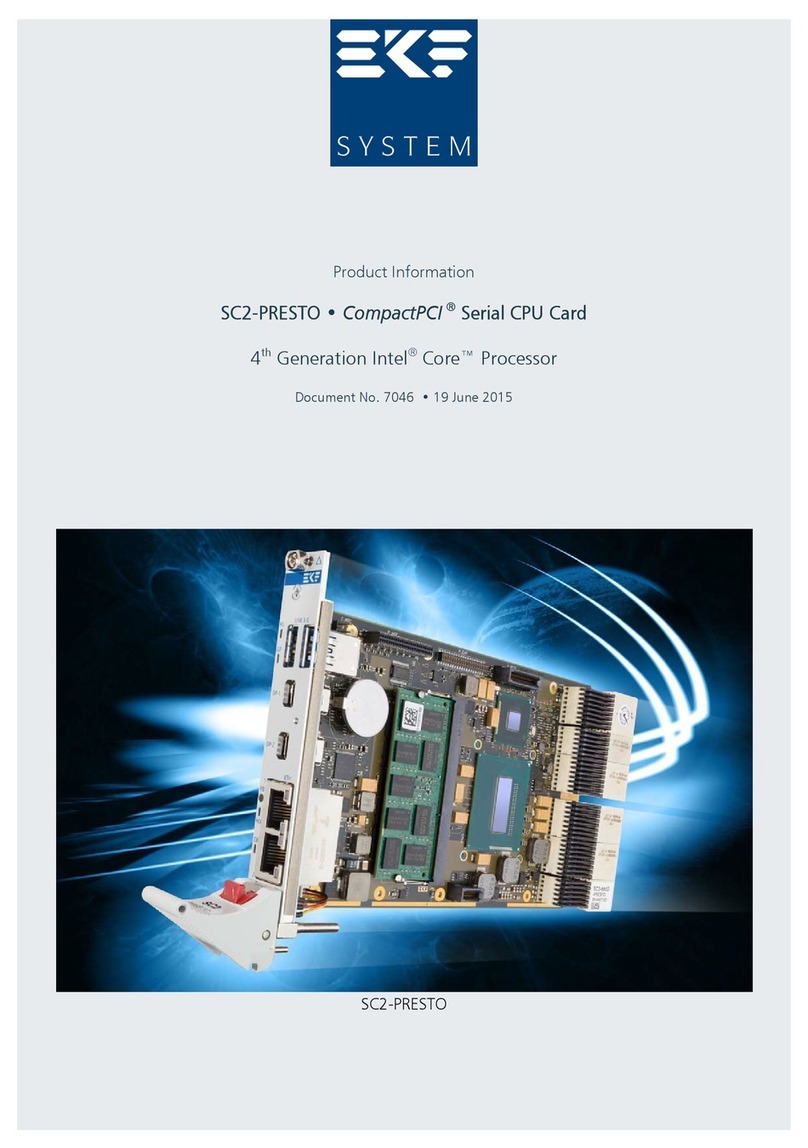
EKF
EKF SC2-PRESTO CompactPCI User manual
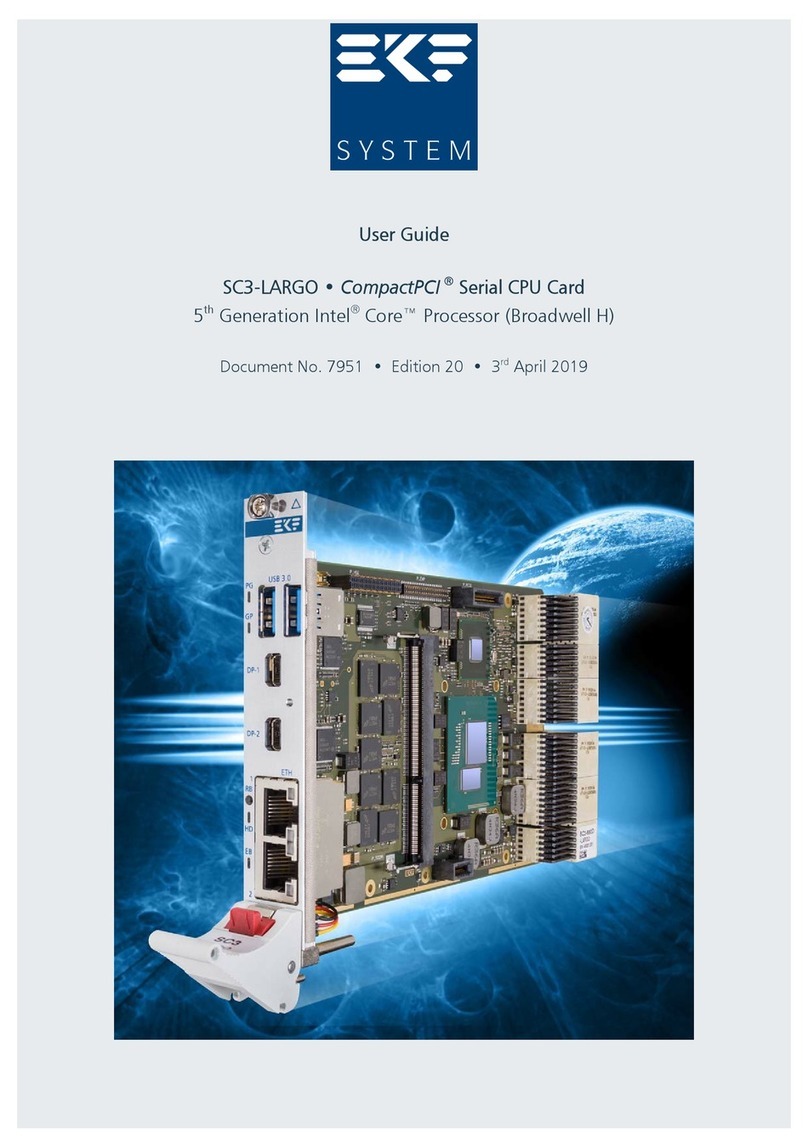
EKF
EKF SC3-LARGO User manual
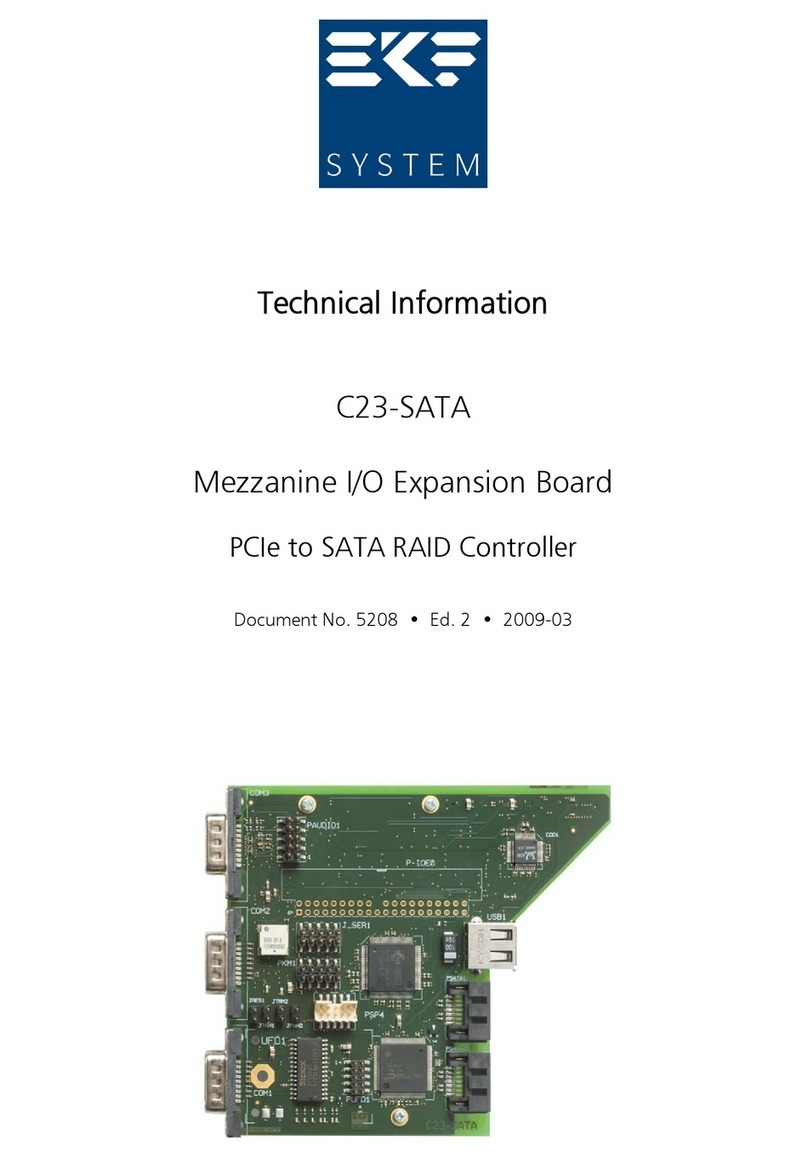
EKF
EKF C23-SATA Manual
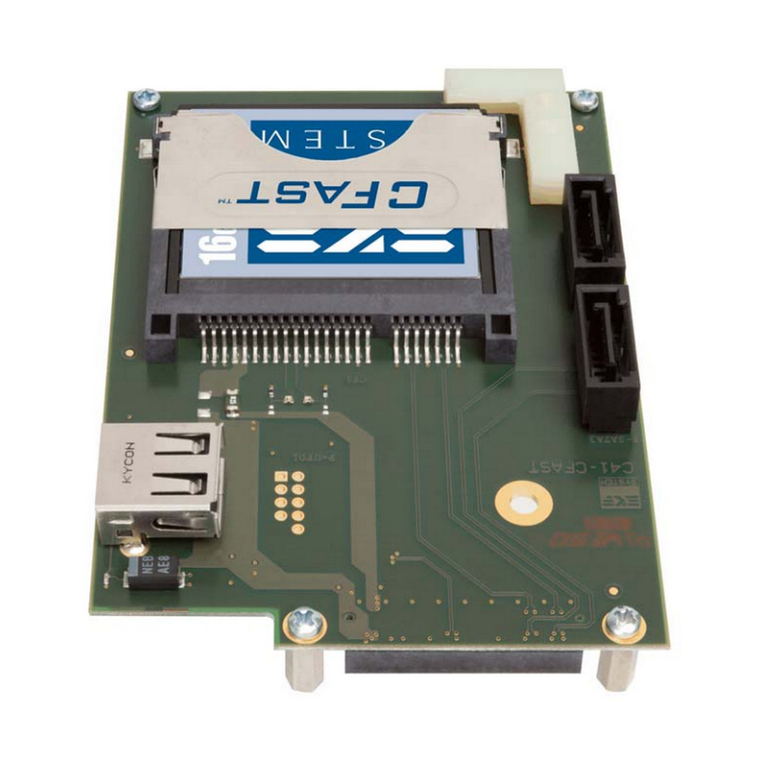
EKF
EKF C41-CFAST Manual
